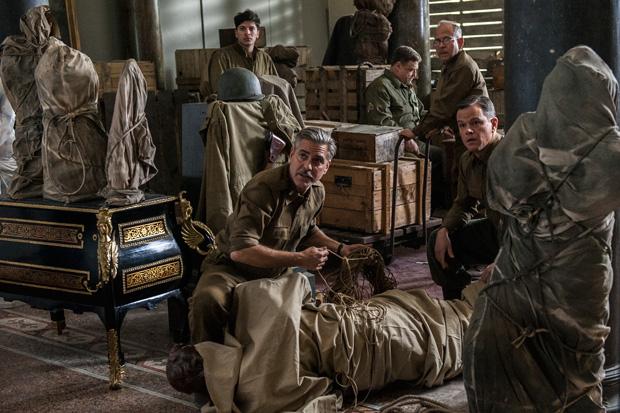‘Monuments Men’ goes for war action, not WWII history
Published February 6, 2014
“The Monuments Men” is a fictional film based on the real effort, near the end of World War II, to save art stolen by the Nazis. What made this effort all the more noble was its second goal, to return the stolen art to its rightful owners, in many cases Jewish families. Where the winners of past wars would have taken these treasures back as the spoils, the Greatest Generation set out to set things right — by undoing one of the Nazi wrongs.
The work of this heroic team of art experts to save stolen art and restore it to its rightful owners was the subject of the excellent 2007 documentary “The Rape Of Europa.” Audiences who had seen this moving documentary were thrilled to hear that a dramatic film was being made of its inspiring events.
With George Clooney as director and star, “The Monuments Men” features a stellar cast, including Matt Damon, Cate Blanchet, Bill Murray, John Goodman and Bob Balaban, along with British actor Hugh Bonneville (familiar to “Downton Abbey” fans) and French actor Jean Dujardin (star of “The Artist”). With such a line-up of talent, how could it go wrong? Yet changing the release date from late last-year (in time for Oscar season) to this February, likely meant something was amiss.
“The Monuments Men” is not a bad film so much as a disappointing one, especially in light of the rich dramatic material in the remarkable documentary. Unfortunately, this version comes across as a more routine war movie.
The film opens with a scene in a Belgian church where priests are dismantling a famous work of art, the Ghent altar piece, to hide it from the Nazis. It’s a bit puzzling because, while the Nazis certainly were willing to snatch art from churches, they were more interested in confiscating it from national museums and, in particular, collections owned by Jews.
The Nazis seemed obsessed with art. Hitler, a failed artist, was collecting the greatest art for a museum in his hometown and many top Nazis were connoisseurs. Further, the Nazis were also interested in seizing art by Jewish artists and in seizing Modern art, which they considered “degenerate,” with the intention to destroy both. As “The Rape of Europa” showed, these so-called “monuments men” were keenly aware that the Nazis were not just stealing art but also destroying it.
After its odd opening scene, “The Monuments Men” seems to right itself and focus on history, as the cast of characters is introduced. Frank Stokes (George Clooney) convinces the U.S. military of the importance of saving art as the war winds down, rescuing it both from the Nazis and from the Allies’ bombs. He assembles a team of art and architecture experts, dubbed the monuments men, to save significant buildings as well as stolen art (the team includes an all-star cast including Matt Damon, John Goodman and Bill Murray).
Meanwhile, in Paris, Claire Simone (Cate Blanchet) is a French woman working as a secretary for the Nazi command that is confiscating art from Jewish French families, but she is actually with the Resistance.
“The Monuments Men” is much more of an action film than a historical one, which is unfortunate given the dramatic potential in the actual history that forms its basis.
Where the movie goes right is when it focuses on the true history and remarkable work of this usual group of heroes, saving art in the midst of war. The cast is marvelous, photography and locations are stunning and the production values are first-rate in every sense.
Where the movie goes wrong is in its script, which too often drifts into familiar Hollywood war movie set pieces, such as soldiers in camp receiving mail or buddies under fire scenes, as a way to create human drama. As the documentary amply showed, there was already plenty of real human drama in the actual events, but the film skips these in favor of standard action film rubrics.
The result is a film that is Hollywood-ed up to the point where it deflates the power of the real historical tale. Although there are Jewish characters and some Jewish content, there is much less than one might expect given the historical basis. The film also says surprisingly little about the looting of museums and galleries and the destruction of Modern art, and nothing at all about the targeting of works by Jewish artists.
While “The Monuments Men” works well enough as just entertainment, it is better if audiences have already seen the documentary so they know what is being left out. It is a shame, really, that the fictional adaptation did not portray a more complete historical picture.
“The Monuments Men” opens Friday and has a running time of 110 minutes.















